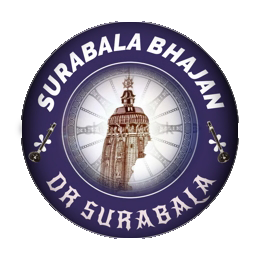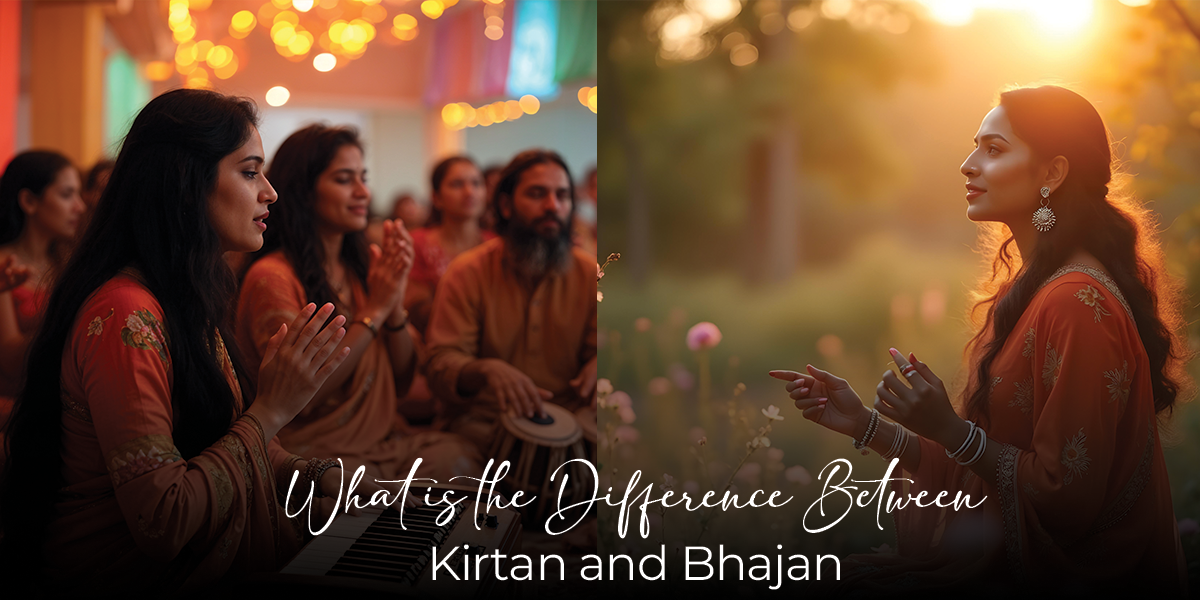Indian devotional music is a beautiful tradition that helps us connect with the divine and explore ourselves. Two important forms of this music are kirtan and bhajan. Kirtan is a lively, community-based chant where people sing together. Krishna Bhajan, on the other hand, is more peaceful and personal, with songs that help us reflect deeply. Together, they create a wonderful mix of energy and introspection that works as wonder.
Let’s look at the differences, origins, and roles of kirtan and bhajan in spiritual practice.
Understanding Kirtan:
Kirtan is a type of singing where people respond to a leader’s chant. The word “kirtan” comes from the Sanskrit word “kirt,” which means “to tell, sing, or praise.” In kirtan, people chant sacred words, mantras, or verses, often from holy books like the Bhagavad Gita, Ramayana, or Puranas. Hence, It’s a way to connect with the divine through music and group participation.
Key Features of Kirtan
-
Call-and-Response Format
A special feature of kirtan is the call-and-response style. Specifically, the lead singer sings a line, and the group repeats it, creating a lively, interactive atmosphere. As a result, this format fosters a sense of community and active participation, making the experience more engaging for everyone involved.
-
Instrumentation
Kirtan is usually played with instruments like the harmonium, mridangam, tabla, as well as cymbals (kartals). In some places, modern instruments like guitars or keyboards are also used.
-
Energetic and Collective
Kirtans often become more energetic. therefore, encouraging people to sing, clap, and even dance. This shared experience makes it inspiring and fun.
-
Focus on Bhakti (Devotion)
At the heart of kirtan is devotion to the divine. Repeating the divine name (naam sankirtan) is believed to not only purify the mind but also elevate the soul.
-
Public and Collective Worship
Kirtans are often held in temples, satsangs (spiritual gatherings), or public events. They thrive on collective energy. Thus developing a shared devotion.
Purpose of Kirtan
The main goal of kirtan is to create a spiritual connection, thereby allowing people to feel closer to the divine. Moreover, its collective nature brings joy, unity, and a deep devotional experience, encouraging a sense of shared devotion among participants.
Understanding Bhajan:
Another very popular type of devotional music is bhajan. The term “bhajan” comes from the Sanskrit root bhaj, meaning “to share” or “to worship.” Bhajans are typically solo or group renditions of devotional songs that express love, adoration, or longing for the divine.
Key Features of Bhajan
-
Structured Song Format
Firstly, Unlike the free-flowing nature of kirtan, bhajans are composed with a clear structure, including verses additionally a repeating chorus. thus, The lyrics often convey deep philosophical meanings, moral teachings, or narratives about deities.
-
Wide Range of Styles
Secondly, Bhajans vary widely in their musical style and regional influences. From classical renditions in ragas to folk melodies, the style depends on the cultural and linguistic context.
-
Lyrical Emphasis
Then, The lyrics of bhajans are central. They are often poetic and rich in imagery, depicting stories from scriptures, praising the divine, or reflecting on life’s spiritual truths.
-
Gentle and Meditative
Furthermore, Bhajans are typically calm and contemplative, encouraging introspection and personal devotion. The pace and mood are usually quieter than kirtan.
-
Solo or Small Group Singing
Lastly, While bhajans can be performed in larger gatherings, they are often sung in smaller, more intimate settings like homes or small prayer groups.
Purpose of Bhajan
The essence of bhajan lies in creating a personal, emotional connection with the divine. It invites individuals to reflect, meditate, and immerse themselves in the beauty of devotion. Unlike kirtan’s collective spirit, bhajan fosters a quiet, personal form of worship.
Comparing Kirtan and Bhajan:
Here’s a side-by-side comparison of the two art forms to highlight their unique characteristics:
| Aspect | Kirtan | Bhajan |
| Format | Call-and-response singing | Structured song format with verses and chorus |
| Mood | Energetic, dynamic, and communal | Gentle, contemplative, and personal |
| Participation | Highly interactive; audience repeats phrases | Often solo or small group singing |
| Musical Style | Improvisational and repetitive | Fixed melodies, often rooted in classical or folk music |
| Lyrics | Short, repetitive phrases or mantras | Detailed, poetic lyrics conveying deep meanings |
| Instrumentation | Harmonium, tabla, cymbals, mridangam, etc. | Harmonium, tabla, and sometimes tanpura |
| Purpose | Collective worship, spiritual elevation | Personal devotion and introspection |
| Setting | Temples, satsangs, public gatherings | Homes, prayer meetings, or small groups |
The Overlap Between Kirtan and Bhajan:
Despite their differences, kirtan and bhajan share many commonalities. Firstly, both aim to evoke a sense of bhakti (devotion) and ananda (bliss). Secondly, they are vehicles for spiritual expression, transcending religious boundaries and uniting participants in their shared love for the divine. In addition, in many spiritual gatherings, kirtan and bhajan are seamlessly integrated. For example, a session may begin with meditative bhajans and then transition into high-energy kirtans, creating a spiritual journey that moves from inward reflection to outward expression. Thus, both practices work together to guide the practitioner through a complete spiritual experience.
How to Experience Kirtan and Bhajan:
1. Attend a Satsang or Bhakti Gathering-
Experience the energy of live devotion at a Satsang or bhakti gathering. The collective chanting in kirtan creates unity, while bhajans inspire introspection. Whether at a temple, community hall, or retreat, these events offer a transformative experience for everyone.
2. Join Online Communities-
Thanks to the digital age, you can enjoy kirtan and bhajan from anywhere. Platforms like YouTube, Facebook, and Instagram host live streams and recorded sessions. Joining virtual satsangs and bhakti groups helps you stay connected and inspired, no matter where you are.
3. Explore Different Genres-
Kirtan and bhajan come in many styles, from traditional Carnatic and Hindustani music to modern blends with global influences. Explore various genres, like Marathi abhangs or Bengali Shyama Sangeet, to find the styles that resonate with you.
4. Learn and Practice-
Getting involved by singing or playing instruments like harmonium or tabla deepens your connection. You can find online tutorials, local classes, or spiritual workshops to improve your skills and share the joy of kirtan and bhajan with others.
Conclusion:
To sum up, kirtan and bhajan may differ in style, but both are powerful ways to grow spiritually and connect with others. Kirtan, with its lively and collective energy, pairs beautifully with the peaceful and introspective nature of bhajan. Together, they create a rich, uplifting experience that helps people connect with the divine.
At the heart of this tradition is Surabala Bhajan, a source of authentic and soulful devotional music. Whether you’re seeking the joy of shared spiritual moments or the peace of personal devotion, Surabala Bhajan offers a timeless path to the divine. Let their music guide you to a place of deep peace, inspiration, and the bliss that true devotion brings.

